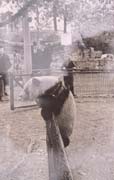|
 A rare animal peculiar to China, the giant panda is known as the "National Tresure" of China. It was also known as a "living fossil", for millions or even tens of millions of years ago, it developed from the carnivore and retains many of the characters of early species in nature. For that reason, it has great scientific value for researches on the evolution of nature and its species. Being such a treasurable A rare animal peculiar to China, the giant panda is known as the "National Tresure" of China. It was also known as a "living fossil", for millions or even tens of millions of years ago, it developed from the carnivore and retains many of the characters of early species in nature. For that reason, it has great scientific value for researches on the evolution of nature and its species. Being such a treasurable  animal, the giant panda also has the longest manual raising history in China. According to Records of Historian, Emperor Huangdi once bred "Pixiu" (giant panda) for battle use. "Yunmeng Moor" in East Zhou Dynasty and "Shanglin Garden" in Qing Dynasty and Han Dynasty both had raised "Mo" (giant pandas). animal, the giant panda also has the longest manual raising history in China. According to Records of Historian, Emperor Huangdi once bred "Pixiu" (giant panda) for battle use. "Yunmeng Moor" in East Zhou Dynasty and "Shanglin Garden" in Qing Dynasty and Han Dynasty both had raised "Mo" (giant pandas).
Outside China, Japan was the first to raise giant pandas. As was recorded, the Empress Wuzetian of the Tang Dynasty once sent the Emperor of Japan a couple of giant pandas for raising. In the modern Western world, the Chicago Zoo of the United States did manual panda raising first. It raised a male giant panda named "Sulin." In modern China, Beipei Public Park (now Beipei Park ) of Chongqing and Zhaofeng Park of Shanghai were the first to respectively raise a giant panda, but both not for long.

Current Situation of Breeding Pandas
|